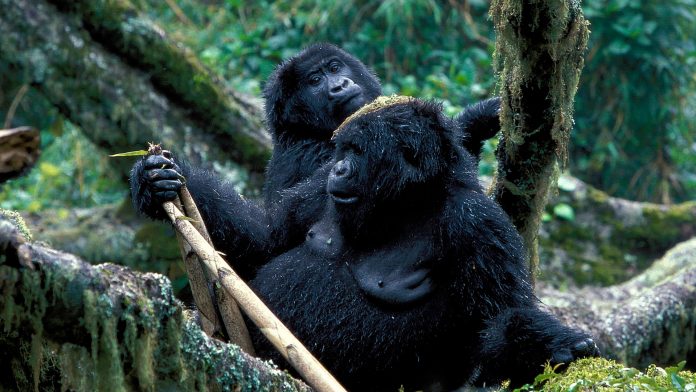A new study published in Frontiers in Conservation Science has revealed that endangered mountain gorillas’ drinking frequency has increased as temperatures rise.
The endangered mountain gorilla is a subspecies of the eastern gorilla. There are only two populations, one in the Virunga volcanic mountains that border Rwanda, Uganda, and the Democratic Republic of Congo, and one in the Bwindi Impenetrable National Park in Uganda.
Mountain gorillas are listed as endangered in the International Union for the Conservation of Nature (IUCN) Red List, and face continuous threats such as small population size, limited habitat, poaching, and habitat destruction. There are only approximately 1,000 individuals left.
How did researchers make this discovery?
Researchers utilised 10 years of data from observations made on the two existing endangered mountain gorilla populations that remain and discovered that both populations consumed water significantly more often, and at higher average temperatures than cooler ones.
The results have important implications for the behaviour and conservation of mountain gorillas, which are faced with continued increases in temperature and frequency of extreme weather events due to the climate crisis.
How will the endangered mountain gorillas’ reliance change?
Mountain gorillas are rainforest dwelling species and rely on plants for a majority of their water requirements. However, increasing temperatures will make the gorillas more reliant on free-standing water, such as a streams, rivers, puddles, or swamps. Because mountain gorillas live at higher elevations, they are also more susceptible to faster temperature rises.
“Understanding how animals obtain water is increasingly important in the face of climate change, as warmer temperatures and more extreme weather conditions are predicted to influence water availability, which could have implications for how they use their limited habitat,” explained author Dr Edward Wright, from the Max Planck Institute for Evolutionary Anthropology.
“This is particularly important in endangered species which are vulnerable to extinction, such as mountain gorillas.”
Was the water temperature impacted by climatic conditions?
To investigate if the water drinking habits of mountain gorillas were impacted by changes in climatic conditions, the research team examined the water drinking behaviour between 2010 and 2020 in the two remaining populations of mountain gorillas of Bwindi and Virunga and correlated this to local maximum temperature and rainfall.
Scientists discovered that both populations demonstrated an increase in water drinking at higher average temperatures than at cooler ones.
“Mountain gorillas drink water more often as the temperatures increases. In these conditions, drinking water likely helps to maintain a healthy body temperature range,” noted Wright.
A greater reliance on free-standing water has several impacts on the survival of these endangered animals. A higher frequency in water drinking may lead to more parasite and human disease exposure. Moreover, because mountain gorillas are a small, isolated species with a limited habitat range, water availability is not always guaranteed in the home range of each group.
Other research has shown that 22% of primate species are vulnerable to the impacts of droughts, while primate habitats are predicted to experience 10% more warming than the global average increase in temperature. By 2050, temperatures in the habitats of mountain gorillas are projected to increase by 1°C to 2.5°C.
While extensive conservation efforts have moved the mountain gorilla populations from ‘critically endangered’ to ‘endangered’ on the IUCN Red List, this study shows that the climate crisis may have new and unexpected negative consequences on the conservation and overall survival of the species.
“Our results suggest that mountain gorillas may have to work harder to maintain water balance in the future,” concluded Wright.
To keep up to date with our content, subscribe for updates on our digital publication and newsletter.









